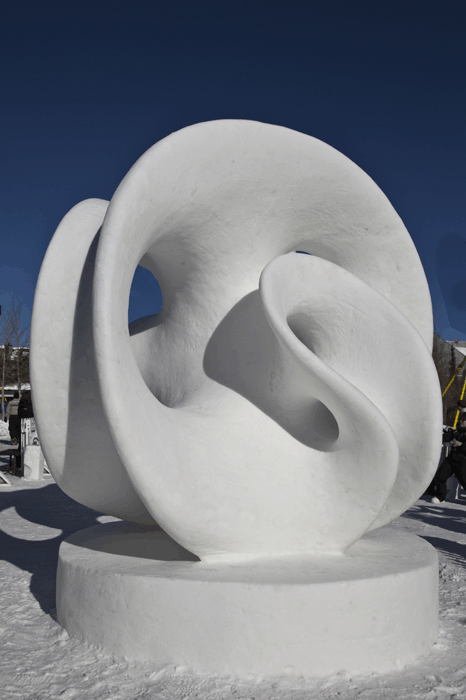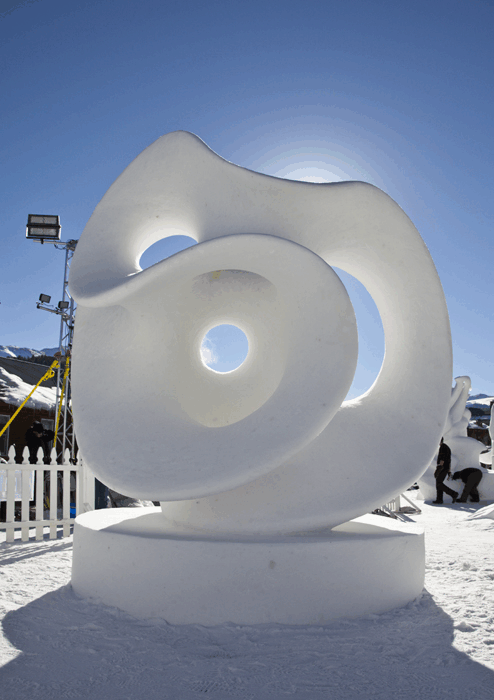
Friday and Saturday: The finish line
We started work at 7:30 on Friday morning and worked until 1:30 am on Saturday, slept a few hours, and returned to the site at 5:30 am. Then we continued fine-tuning until the end at 10:00 am. Both Friday and Saturday were fully sunny and warm. That makes for decent photography, but it can be hard on the sculptures. The highs both days were about 40 degrees, and that is tolerable. Our piece was essentially unchanged by Saturday night.
We are extremely pleased with the result of the week’s work. The sculpture is just what we wanted, matching the model in all detail. Eva worked long and hard at shaping the final curves, and the results of her fine eye and arms are evident. Dan did all the work up high (and lots down low), putting to work all the techniques he learned from our previous sculpting partners. Rich did a little of everything, while at the end I focused mostly on the base and patching work for the small holes that inevitably show up. Beth, our non-sculpting member, did a superb job of snow removal, which is essential to the efficient working of the team.
The sculpture was dangerously thin at some points (three inches, with light shining through at times), as it is difficult to monitor the thickness away from the edges. But there were no serious problems. We rounded all the edges, whereas in our past work our edges were straight ends, about 5 or 6 inches wide. We used a template to carve the final circle to the correct shape, starting with a circumscribed 16-gon. Those 16 cuts around the bottom were tough, as the wire saw did not work well down low; we used the very old four-foot long wood saw Helaman Ferguson left with us many years ago.
We can’t say enough about Eva’s efforts in traveling thousands of miles, and two miles up, to work with us, a bunch of strangers whom she had no choice but to trust. Dan pointed out her bravery in carving the surface down to the limits of thinness. The design is not risky in any sense related to gravity, but it is risky in terms of the thinness one needs to make it look good. We tapered the ends down to a soft edge, a style we have never used before
Here is an amusing quote from the book about Eva’s work cited earlier: “Sculptures for outdoor locations need to be made from durable materials.”
Special thanks to those who helped with tools: Bob Salazar, who made an effective circle-template-and-rasper out of an older tool made of Lexan, Jonathan Kriegel, and Dave Blakeslee. As always, the Town of Breckenridge must be congratulated for producing the exquisite, very dense snow blocks that we get to play with. The other teams are fun as always, and we appreciate those that share their insights into the medium and the best tools for working it. The Wisconsin team on one side of us was especially helpful with tool repairs and the like. One of them offered to make this piece out of concrete, at the same size, if we could get a large enough mold!

In 1999 one of the best photos was sending a little girl through the Costa surface. We could do the same this year.

Sculptors are perfectionists, wanting perfect curves. So this was Eva’s basic position for a day and half, all over the sculpture. The full sun on Friday and Saturday was not a big problem for us. We had a massive side facing southwest, and that served to shield the more delicate regions from the sun.

Dan was in his element: Using his good technique and size to shape and finish things well.

Here are several views of the finished work. The video here gives a 360-degree walk around the sculpture. Above: From the south. We arranged it so that the fairly solid double-lobe corner faced southwest (above Beth in the photo below) and so was most exposed to the sun.

The team, from the southeast. Beth, Rich, Eva, Stan, and Dan (photo by Kathy Schwalbe).

Above: From the northwest.

Above: From the northeast. There is one hole that is impossible to see in photos. In the main indentation in the photo above one sees two lighter patches indicating a hole to the left and a hole down. There is also a hole up from this area all the way to the roof. This meant that snow from work on the roof fell through the upper hole, and then down the lower one all the way to the tunnel, where it ended up being scooped out by hand.

Above: From the north.

Above: From the east, a few hours before the 10 am finish. As always when we are working, the model is not far away (on table at far right).